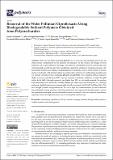Por favor, use este identificador para citar o enlazar a este item:
http://hdl.handle.net/10261/332571COMPARTIR / EXPORTAR:
 SHARE SHARE
 CORE
BASE CORE
BASE
|
|
| Visualizar otros formatos: MARC | Dublin Core | RDF | ORE | MODS | METS | DIDL | DATACITE | |

| Título: | Removal of the Water Pollutant Ciprofloxacin Using Biodegradable Sorbent Polymers Obtained from Polysaccharides |
Autor: | Alvarado, Sarah; Megia-Fernández, Alicia; Ortega-Muñoz, Mariano; Hernández-Mateo, Fernando; López-Jaramillo, F. Javier; Santoyo-González, Francisco | Palabras clave: | Cross-linking Ciprofloxacin Divinyl sulfone Emerging pollutant Biodegradable polymers Sorbent material Water management |
Fecha de publicación: | 27-jul-2023 | Editor: | Multidisciplinary Digital Publishing Institute | Citación: | Polymers 15(15): 3188 (2023) | Resumen: | Water use has been increasing globally by 1% per year, and recycling and re-use are critical issues compromised by the presence of pollutants. In this context, the design of novel materials and/or procedures for the large scale-removal of pollutants must be economically and environmentally feasible in order to be considered as part of the solution by emerging economies. We demonstrate that the cross-linking of biodegradable polysaccharides such as starch, dextrin, or dextrin and β-cyclodextrin with divinyl sulfone is an innovative strategy for synthesizing insoluble and eco-friendly sorbent polymers, including pSt, pDx and pCD-Dx. The evaluation of these polymers’ ability to remove ciprofloxacin (CIP), a prime example of antibiotic pollution, revealed that pSt, with a Kd of 1469 L/kg and a removal rate higher than 92%, is a favorable material. Its sorption is pH-dependent and enhanced at a mildly alkaline pH, allowing for the desorption (i.e., cleaning) and reuse of pSt through an environmentally friendly treatment with 20 mM AcONa pH 4.6. The facts that pSt (i) shows a high affinity for CIP even at high NaCl concentrations, (ii) can be obtained from affordable starting materials, and (iii) is synthesized and regenerated through organic, solvent-free procedures make pSt a novel sustainable material for inland water and seawater remediation, especially in less developed countries, due to its simplicity and low cost. | Versión del editor: | https://doi.org/10.3390/polym15153188 | URI: | http://hdl.handle.net/10261/332571 | DOI: | 10.3390/polym15153188 | E-ISSN: | 2073-4360 |
| Aparece en las colecciones: | (IQAC) Artículos |
Ficheros en este ítem:
| Fichero | Descripción | Tamaño | Formato | |
|---|---|---|---|---|
| Removal_of_the_Water_Pollutant_Alvarado.pdf | 2,22 MB | Adobe PDF |  Visualizar/Abrir |
CORE Recommender
SCOPUSTM
Citations
1
checked on 05-may-2024
Page view(s)
32
checked on 13-may-2024
Download(s)
28
checked on 13-may-2024
Google ScholarTM
Check
Altmetric
Altmetric
Este item está licenciado bajo una Licencia Creative Commons

